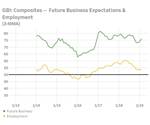Brazilian composites sector shows third consecutive year of growth
Maxiquim’s recent study notes that the transportation and electric sectors are responsible for $560 million in revenue.

Source | ALMACO
A recent study by Maxiquim (Porto Alegre, Brazil), a consultancy contracted by the Latin American Composite Materials Association (ALMACO), shows the Brazilian composites sector achieved its third consecutive year of growth in 2019. Turnover was 5.6% higher than recorded previously at $560 million. In volume, the increase was 8.3%, totaling 218,000 tons consumed.
“The transportation and electric segments were mainly responsible for this performance. Also noteworthy is the increase in demand from the marine market, although it represents little in terms of volume. The civil construction industry, which was less important in 2019, still leads the ranking of the main Brazilian composites consumers,” says Erika Bernardino Aprá, president of ALMACO.
According to the Maxiquim survey, civil construction accounted for 32% of Brazilian consumption of polyester composites, ahead of transport (27%), corrosion/sanitation (22%), electricity (4%), wind energy (4%) and marine (2%). When the demand for composites based on epoxy resin was separated, the generation of wind energy led with 89%, ahead of oil and gas (6%) and electronics (2%).
Of the 218,000 tons of raw materials processed last year, the survey pointed to the following division: polyester resin (114,000 thousand), fiberglass (60,000), epoxy resin (21,000), gelcoat (12,500) , vinyl ester resin (2,300), structural adhesive (2.2 thousand), carbon fiber (2.6) and others (4), representing peroxides, additives and mineral fillers.
Regarding the processes adopted by the Brazilian composites manufacturers, manual technologies such as hand layup and sprayup had a 52% share, followed by automated systems, such as RTM (8%), pultrusion (7%), filament winding (6%), continuous lamination (5%), BMC/SMC (5%), infusion (4%) and other (12%).
Maxiquim's research was completed at the beginning of the coronavirus pandemic. Therefore, data on expectations for 2020 had to be disregarded, ALMACO said in a statement. “Nobody knows for sure how much damage the strike will do to the economy as a whole. We are waiting for further developments to redo the study and disclose new perspectives on the composites market.”
Additional information can be found at ALMACO’s website.
Related Content
-
JEC World 2023 highlights: Recyclable resins, renewable energy solutions, award-winning automotive
CW technical editor Hannah Mason recaps some of the technology on display at JEC World, including natural, bio-based or recyclable materials solutions, innovative automotive and renewable energy components and more.
-
Recycling end-of-life composite parts: New methods, markets
From infrastructure solutions to consumer products, Polish recycler Anmet and Netherlands-based researchers are developing new methods for repurposing wind turbine blades and other composite parts.
-
MingYang reveals 18-MW offshore wind turbine model with 140-meter-long blades
The Chinese wind turbine manufacturer surpasses its 16-MW platform, optimizes wind farm construction costs for 1-GW wind farms.
















